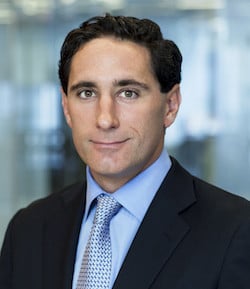
The adjustment to trading OTC derivatives on swap execution facilities is proving to be difficult for buy side institutions that are used to calling their bank or using a single-dealer platform.
Following the Made Available to Trade (MAT) determinations, which kicked off mandatory SEF trading on February 18, institutions and end users of derivatives have taken what can be best described as a toe in the water approach.
“Six weeks in, we are still seeing relatively cautious client behavior, and by clients, we mean real money asset managers,” said Chris Amen, head of U. S. institutional rates markets at Tradeweb. “There’s a lot of noise as it relates to the volume activity on SEF’s, but you really need to understand who’s driving those volumes. A lot of it is driven by larger broker dealers, and clients’ flow has been somewhat less. We believe about 10% – 15% of the overall swaps marketplace is being trading on SEF, at this point.”

Chris Amen, Tradeweb
Charley Cooper, senior managing director at State Street Global Markets, said that post-execution processing is a major pain point.
“After clients have done the trade on the SEF, we need to understand the implications that trade will have for all of our downstream processing. what implications that trade will have for our collateral and capital demand now that we need to post margin in a clearinghouse, and what types of analytics we need to help determine overall market position.”
With the May 15 deadline for packaged trades to be mandated for trading approaching, Amen expects to see a jump in SEF activity. “We still don’t have the full breadth of swaps instruments MAT-certified to trade on SEFs. We have a number of clients that are still wading into the swap market slowly,” he said.
The reasons are two-fold, according to Amen. First, many customers don’t trade outright plain vanilla swaps. “There are a lot of institutions that trade packages, say swaps versus Treasuries, that aren’t yet trading on SEFs,” he said.
Second, the connectivity and overall workflow of electronic trading in swaps is relatively new for many market participants. “You have a lot of institutions that are just being more cautious and making sure they have all their systems and compliance components working properly,” Amen said.
Tradeweb has built connectivity throughout the entire electronic derivatives trading workflow, including FCM’s, DCO’s, and market makers.
“We spend a lot of time with clients trying to understand their needs and help them benefit from customized technology solutions to handle their workflow with confidence,” Amen said. For example, customers often require specialized support to help map the flow of trade information on a post-trade basis, as with bunched orders, where Tradeweb can help enhance a secure flow of transaction data where they need it.
Although listed derivatives such as swap futures and index futures can act as a proxy for OTC swaps, the expectation among SEF operators is that most trades will be executed on-SEF.
“There are a number of products that clients can access, away from the swap markets, to express or to handle their portfolio hedging or duration needs, such as the Treasury futures marketplace,” Amen said. “But because the swap futures marketplace hasn’t really taken off yet, we believe that once MAT is completely out there and when clients have completed their connectivity and order management system issues, a meaningful part of the swap marketplace will be traded electronically on SEFs.”
Featured image via iStock





